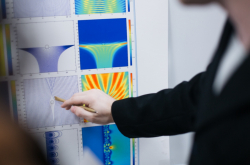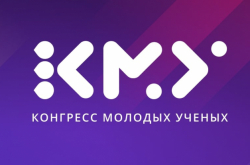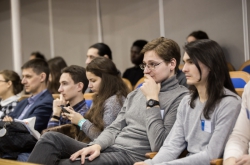The Congress of Young Scientists has existed for 15 years already. At first, this was a interuniversity conference for young scientists that involved six subject areas. With time, it grew into a nationwide event with 50 different sections, various schools, round tables and contests, including a contest of scientific presentations that gives an opportunity to enter a Master's program without having to take exams. Nowadays, over 2,000 school and university students participate in the Congress; their reports are published in a special compilation that will be included in the Russian Science Citation Index.
This year, 146 high school students from different Russian cities signed up for the event; 116 of them presented their reports in nine of the congress's sections; the most notable projects were presented in the Photonics section, including a project by Dmitry Vladimirtsev from St. Petersburg's Lyceum #239 - you can read an interview with him here. ITMO.NEWS also interviewed other participants about their research and experiences.

Alina Korchilaeva from the Engineering Sciences and Energy-efficiency section
In my project, I spoke about the prospects of using semiconductors created by sol-gel synthesis, and presented samples that I created at school. My main goal was to research the sol-gel method, create samples and study them using both probe and optical microscopes. At my school, every 8th and 10th-grader has to complete research projects. During my 10th year at school, I decided to focus on some serious research, but it seemed almost impossible to do something other than boring theoretical studies with the scarce opportunities that you find at school. Still, this was the year when we got a lecturer in nanophotonics, so I asked him for advice. It turned out that you can do an interesting project with the equipment we have at school, and so I did mine.
As for the congress, I learned about it by accident from one of ITMO University's web communities. The Congress was most memorable, I really liked other participants' projects, and got the opportunity to ask questions and learn a lot of new things by communicating with the members of the jury. I suppose that this educational format was, is and will be the most interesting for me and high school students in general.

Olga Kadison, Biotechnology section
My topic has to do with the relevant problem of healthy nutrition of students who lead an active lifestyle and aspire to manage: lectures, homework, parties, and part-time work. In order to succeed in doing that, they need lots of energy. Food is the main source of energy, and an important part of our lives. I started to think of a way to make the nutritive process not just a necessity, but something healthy and pleasant, as that can encourage young people to eat a healthy diet. Thus, the goal of my project was to find an alternative approach to the nutrition industry and show that eating right is not that hard.
Most teenagers already have health problems that are further festered by a messed up dietary pattern due to the short lunch breaks and long queues at canteens. I conducted a small research and learned that at my school, the most widespread health problems amongst students are gastrointestinal diseases and diseases of the endocrine system as well as allergic disorders. Having analyzed the corresponding nutritional care, I’ve come up with an example of a daily ration that can become part of a complex diet. I also added information on several smart technologies from the field of public catering to my report.
I participated in the Congress of Young Scientists as a representative of the School of Young Biotechnologists, and got invaluable experience that will definitely help me in future, as this year is the year I graduate from high school. Working on this project has been most interesting. I would've liked to continue doing research in this field, i.e. my work for the congress will serve as a foundation for my future plans.
Margarita Seleznyova, Ecology and Sustainable Development section

For my project, I analyzed the main sources of pollution, as well as the automatic data systems that are used for controlling it. As the results of my project, I proposed several possible trends for developing technologies that can contribute to environmental safety. I decided to focus on this topic, as air pollution is the most dangerous type of pollution. Every year, millions of people die from related issues. New inventions in the field I focused my presentation on can improve the welfare of people thanks to the introduction of automatic data systems and help control, minimize and prevent atmospheric contamination.
Ruslan Garifullin, Engineering of the Future: Management, Computations, Security section (section’s award winner)
I had the task of creating a Web-based crossplatform OS, as well as a software suite for working with files and in the Internet. In order to do that, I analyzed the existing operating systems of a similar type and learned the common principles and advantages of these systems. I sought inspiration from the design and functionality of different operating systems. I also got involved in development of different web applications and Internet services (file sharing services and social networks). Combining these two technologies and getting something new as a result proved to be most interesting. As result, we've created OnlineStor - a web-based desktop system, and then an OS based on similar principles.

In my work, I tried to show that web-technologies will soon become dominant in the field of user interfaces, and the first step to that would be the opportunity to replace desktop programs with web-applications. As for the practical importance of the project, it promotes using web programming languages in common desktop programs, as well as the creation of operating systems that would be even more adaptive than Linux.
I learned about the Congress of Young Scientists from the ITMO.START program. I was attracted by ITMO University’s reputation, as well as the organizers’ commitment to this event. The level of knowledge, reports and projects of colleagues from different sections was very high, listening to their elaborate and confident speech, as well as getting answers to relevant questions was a real pleasure. I also liked the tour of ITMO University when they showed us what kinds of projects its students conduct.
Evgeniya Baburina, Ecology and Sustainable Development section
I study the influence of beavers on the zoobenthos (animal life at the lowest level of a body of water) in submountain rivers. To do that, I usually come to the place, take quality samples of the zoobenthos, water, and then compare samples from different parts of the river. Beavers have their influence on the different parts the river, i.e. parts that are upstream to the beaver dam, downstream of the beaver dam, and where the beaver dam is.
At first, I studied beaver populations in my home region, as the issue with St. Petersburg beavers is quite unique: once, beavers lived on the territory where St. Petersburg now stands, than they were driven out during the constructions of the city, and exterminated by hunters in the Leningrad region. Some time after, beavers from different nature reserves have been brought to the region; beavers from Canadian reserves were brought to Finland, and beavers from European reserves were brought to the Leningrad region. As a result, they migrated and crossbred. Beavers were observed in cities, i.e. they’ve started to inhabit anthropogenic landscapes, and now we know which species - Canadian or Eurasian beavers - now dominate the Leningrad region. I got really interested in this story, which is why I decided to study beavers. What’s more, beavers are really important for ecosystems of waterbodies: a pair of beavers can influence a huge river and over 600 species of plants and animals living there.

I’m currently doing something that no one in Russia has done before; most researchers only study the ecosystems of lowland rivers, submountain rivers and the plankton living there. Studies on the influence on beavers on zoobenthos are only conducted abroad; for one, there’s some data on Canadian beavers. Personally, I want to prove that rivers need beavers, as not everyone understands that.
I decided to take part in the congress, as no one will learn about your work if you don’t present it. What’s the point of working for a whole year then? I got a positive experience from the event, as it has been the first time I ever did an oral presentation - I usually do poster sessions. Still, it’s a shame I didn’t win.
Ekaterina Mashina, Digital Economy section (section’s award winner)

My project is called “The peculiarities of designing a digital platform for supporting citizens' initiatives using the example of EcoDataKeeper”. The point of the project was to create a constantly growing single-window web resource for individual volunteers or volunteering organizations by efforts of an organized international group of 11th-graders. The website was to provide the users with information on projects, legal issues, help find sponsors, and interact with authorities and the media.
In the course of my work for the project, I analyzed similar solutions, created a detailed functional configuration of the proposed solution (IDEF0 model), organized and planned the team’s work, as well as found a considerable number of media sponsors for our project. The solution’s working prototype is currently being tested.
I decided to participate in the project because I frequently participate in volunteering activities, mostly organizing different conservation initiatives. At some point, we came to understand that we are collaborating with volunteers all over Russia, and we need a dedicated platform for systematizing and spreading information.

I aim to dedicate my life to information technologies, which is why this project is something like my first startup. For the next stage of my activities, I am planning to develop a generally available telemedicine information system on the same principles that I used for my current project. I think I’ll start working on it once I enter ITMO University.
It was by chance that I got to participate in the Congress. For about two years, I’ve been actively participating in different events conducted by ITMO University. It happened that I accidentally came to an event that had to do with preparing for the Congress of Young Scientists instead of a volunteering event. And this mistake turned out to be a stroke of luck that got me to participate in the Congress this year, as I was initially planning to start participating in similar events after I became a university student.
Natalya Aleksandrova, Biotechnology section (section’s award winner)

The purpose of my research was to study the composition and physical properties of an ordinary chondrite (a type of chondritic meteorite). I used different methods - from measuring its heat-absorbing capacity with the help of an improvised calorimeter at a school laboratory to X-ray fluorescence analysis of a sample at an analytical center. I chose my topic based on my personal interest in the subject and my dream of becoming an astrochemist. I still can’t come up with a practical application of theoretical research on this topic, though. Still, research on chondrites can definitely give us a deeper insight into our planet’s past and the early stages of its development. At the Congress of Young Scientists, I got the experience of publicly presenting my results and meet many interesting people. This was also a great chance to closer acquaint myself with ITMO University.




